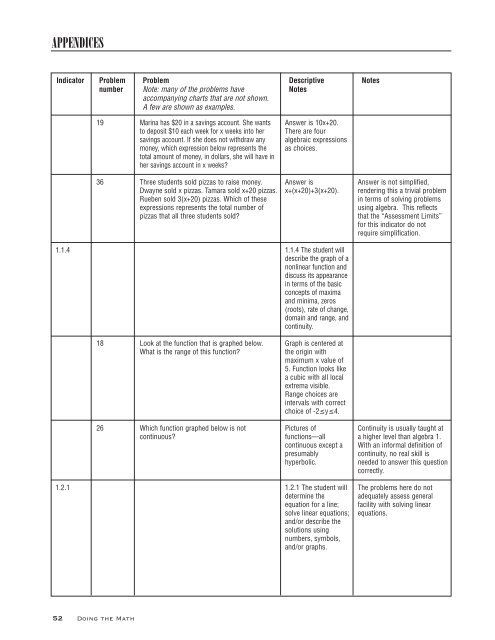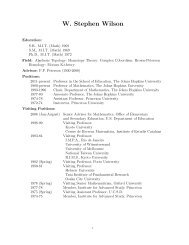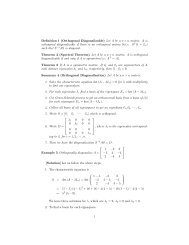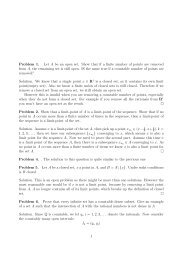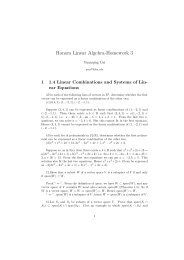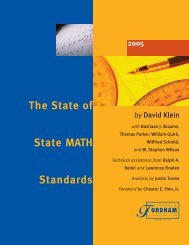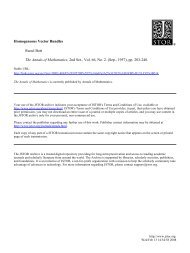Doing the Math - JHU Mathematics - Johns Hopkins University
Doing the Math - JHU Mathematics - Johns Hopkins University
Doing the Math - JHU Mathematics - Johns Hopkins University
Create successful ePaper yourself
Turn your PDF publications into a flip-book with our unique Google optimized e-Paper software.
APPENDICES<br />
Indicator Problem Problem Descriptive Notes<br />
number Note: many of <strong>the</strong> problems have Notes<br />
accompanying charts that are not shown.<br />
A few are shown as examples.<br />
1.1.4<br />
1.2.1<br />
19<br />
36<br />
18<br />
26<br />
52 <strong>Doing</strong> <strong>the</strong> <strong>Math</strong><br />
Marina has $20 in a savings account. She wants<br />
to deposit $10 each week for x weeks into her<br />
savings account. If she does not withdraw any<br />
money, which expression below represents <strong>the</strong><br />
total amount of money, in dollars, she will have in<br />
her savings account in x weeks?<br />
Three students sold pizzas to raise money.<br />
Dwayne sold x pizzas. Tamara sold x+20 pizzas.<br />
Rueben sold 3(x+20) pizzas. Which of <strong>the</strong>se<br />
expressions represents <strong>the</strong> total number of<br />
pizzas that all three students sold?<br />
Look at <strong>the</strong> function that is graphed below.<br />
What is <strong>the</strong> range of this function?<br />
Which function graphed below is not<br />
continuous?<br />
Answer is 10x+20.<br />
There are four<br />
algebraic expressions<br />
as choices.<br />
Answer is<br />
x+(x+20)+3(x+20).<br />
1.1.4 The student will<br />
describe <strong>the</strong> graph of a<br />
nonlinear function and<br />
discuss its appearance<br />
in terms of <strong>the</strong> basic<br />
concepts of maxima<br />
and minima, zeros<br />
(roots), rate of change,<br />
domain and range, and<br />
continuity.<br />
Graph is centered at<br />
<strong>the</strong> origin with<br />
maximum x value of<br />
5. Function looks like<br />
a cubic with all local<br />
extrema visible.<br />
Range choices are<br />
intervals with correct<br />
choice of -2≤y≤4.<br />
Pictures of<br />
functions—all<br />
continuous except a<br />
presumably<br />
hyperbolic.<br />
1.2.1 The student will<br />
determine <strong>the</strong><br />
equation for a line;<br />
solve linear equations;<br />
and/or describe <strong>the</strong><br />
solutions using<br />
numbers, symbols,<br />
and/or graphs.<br />
Answer is not simplified,<br />
rendering this a trivial problem<br />
in terms of solving problems<br />
using algebra. This reflects<br />
that <strong>the</strong> “Assessment Limits”<br />
for this indicator do not<br />
require simplification.<br />
Continuity is usually taught at<br />
a higher level than algebra 1.<br />
With an informal definition of<br />
continuity, no real skill is<br />
needed to answer this question<br />
correctly.<br />
The problems here do not<br />
adequately assess general<br />
facility with solving linear<br />
equations.


